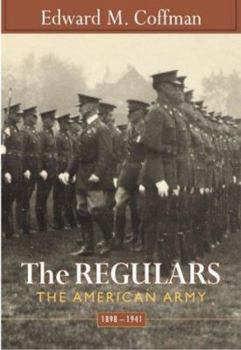The Regulars: The American Army, 1898-1941
Select Format
Select Condition 
Book Overview
In 1898 the American Regular Army was a small frontier constabulary engaged in skirmishes with Indians and protesting workers. Forty-three years later, in 1941, it was a large modern army ready to... This description may be from another edition of this product.
Format:Hardcover
Language:English
ISBN:0674012992
ISBN13:9780674012998
Release Date:April 2004
Publisher:Belknap Press
Length:519 Pages
Weight:1.92 lbs.
Dimensions:1.2" x 6.6" x 9.3"
Related Subjects
History Military Military Science Modern (16th-21st Centuries) Veterans World War ICustomer Reviews
4 ratings
Low-level perspective
Published by Thriftbooks.com User , 18 years ago
Coffman's book traces the evolution of the US military from a frontier force to becoming a modern, WWII fighting machine. The book is unique because it tells the story with first person accounts and it includes chapters on what it was like to be a soldier and a dependent at various locations during the period. From a transformation standpoint, the chapters on the "Managerial Revolution" and "The War to End all Wars" (WWI) are particularly interesting. The last chapter "Mobilizing for War" tells the story of how the Army was able to take itself from a near-broken, depression-era force to one of the most capable armies in the world able to fight major wars on both sides of the world while equipping other armies. This book is a good complement to Guardians of Empire: The U.S. Army and the Pacific, 1902-1940, which is a strategic perspective of the Army in the Pacific in the interwar years.
A brilliant piece of scholarship
Published by Thriftbooks.com User , 19 years ago
I just finished The Regulars : The American Army, 1898-1941, by Edward M. Coffman. It is a social history of the Regular Army, starting in 1898 when it was a tiny frontier constabulatory about to take on an imperial role with the Spanish-American War and subsequent occupations, and ending with the massive mobilization immediately prior to WWII. It describes a military that would be barely recognizable to anybody who has served in the American military in the modern era, along many dimensions (in war and peace, in CONUS and overseas, officer and enlisted, servicemen and families, different branches, traditional technologies such as horses vs. the emerging technologies of tanks and airplanes, blacks and whites, etc.). One thing that was striking to me was the many similarities between the campaign against Filipino insurgents at the turn of the century and the campaign against Iraqi insurgents almost exactly a century later. The author believes that the seeds of the victory in WWII were sown in the pre-war Regular Army. I am not sure that I agree. I think that a strong argument can be made that the pre-war Regular Army was a insular, reactionary, complacent organization, that although it had its bright spots it had tremendous amounts of incompetence and mediocrity, and that the strengths of American society were employed to create essentially a new Army starting in 1940. However, I do not have to agree with the author of a book to recommend it. The book is both a brilliant piece of scholarship and extremely well written. The portraits of people and life in the Regular Army of this period are vivid. It is simply one of the best books I have ever read. If the subject interests you, it is a "must read".
A Changed Army
Published by Thriftbooks.com User , 19 years ago
This a great sequel to Dr. Coffman's "The Old Army." Through the use of Army records, personal papers, memoirs, biographies, questionnairea, and many interviews, he has told the story of a U.S. Army that evolved as the country developed from an insular nation to a major world power. From 1898 to 1941, the Army changed from a frontier constabulary to a global force. It is a fascinating story told in a lively way that brings to life the participants, both the principals and their families, both the soldiers and their officers. While essentially a social history, underlying it all is the story of the transformation of the Army itself. A fascinating and superbly written book.
An excellent history of the american army
Published by Thriftbooks.com User , 20 years ago
Coffman has written an excellent social history of the American army from 1900 to 1940 that puts an emphasis on the educational development of the officer corps. In 1900 a large percentage of the officer corps were from the civil war era and had no interest in further intellectual development, but this changed with an introduction of new junior officers who were educated at Fort Leavanworth, Fort Benning, and the Army War College. These schools encouraged personal intiative in officers and the new study of new technologies such as tanks and airplanes. As a result this new class of officers intellectual interest was the development of the Air Corps and armor in the army. Coffman also writes about how the army was divided along class and racial lines. The families of officers and enlisted men very rarely intermingled with each other, and officer families only married other officer families and not enlisted men. However some enlisted men such as James Gavin rose to become a general. The army was also divided along race with blacks being gradually eased out of frontline service from 1900 to 1940 and the few black officers such as Benjamin Davis were constantly harassed through their time of duty. This is outstanding book about the American army from 1900-1940 and should be read with the books by Brian Linn.




